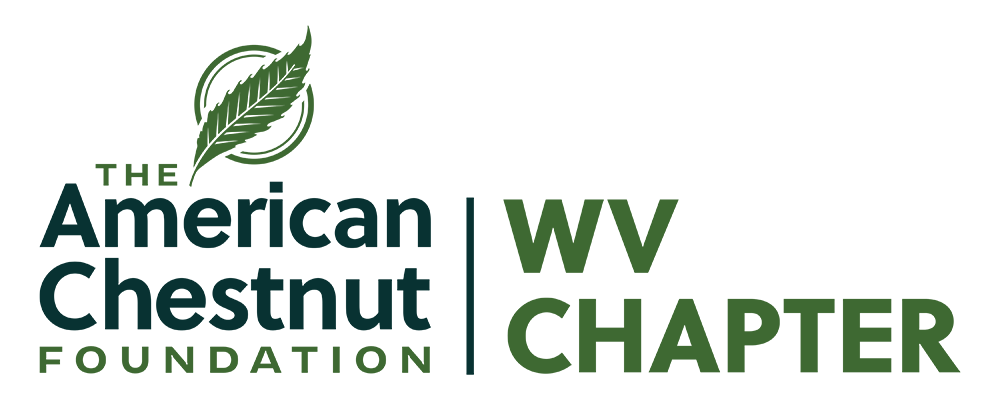
Contact us at gro.fcat@retpahCVW
About Us
The West Virginia Chapter of The American Chestnut Foundation (WV-TACF) was established in 2009, the last of TACF’s 16 state chapters to be incorporated. Hybrid chestnut trees have been planted at 68 sites in 26 WV counties. We have initiated germplasm conservation orchards (pure American chestnut plantings) at seven sites in the state. Chapter members help support the mission of the national organization by planting hybrid chestnuts, conducting education, research, and outreach.
If you would like to participate in this group please join us. We include people from all areas that have an interest in restoring this magnificent tree to our forests. When you join The American Chestnut Foundation, a portion of your dues will be shared with the WV-TACF Chapter.
To learn more about who we are and what we do, read our monthly newsletter!
2025 West Virginia Grant Program
We invite members of the West Virginia chapter of The American Chestnut Foundation and other interested parties to apply for grants up to a maximum of $2,000 to support education, outreach and scholarly activities related to American chestnut in the State of West Virginia. Grants are available to assist individuals with active restoration projects in the State, outreach activities, as well as with their scholarly activities. For more information please download the application form. Submissions are due January 31, 2025.
American Chestnut: The Once and Future Tree
Click play below or watch on YouTube.
In the spring of 2023, a group of film students from the George A. Romero Filmmaking Program traveled throughout West Virginia and Maryland to record oral histories from a group of individuals with a passion for the American Chestnut, in an effort to preserve pieces of the tree’s past, present and future.
Chestnut Identification
Distinguishing American from Chinese and European Chestnut
Sometimes, individuals who come across a tall chestnut tree in a forest setting, assume it must be an American chestnut. This is not always the case. In forest settings, Chinese chestnut, like its American cousin, also can grown straight and tall. Leaf shape, leaf hairs and twig color are good characteristics to distinguish American from Chinese chestnut. American chestnut leaves are generally long and slender with a “V” at the leaf base. Chinese chestnuts have a wider leaf and they are often shiny. Chinese chestnut leaves have a “U” shape at the leaf base. Most striking are the hairs on the under-surface of Chinese chestnut leaves. American chestnut leaves have no hairs. Chinese twigs, generally brown in color, also have hairs. American twigs, generally exhibit a reddish color, and like the leaves, the twigs have no hairs. Buds are another characteristic–American buds are pointed compared to rounded Chinese buds.
In some areas of the eastern U.S., European chestnut trees can be found. In comparison, European twigs are much stouter than either American or Chinese chestnut. Buds on a European are often large and green in early spring, turning darker by mid-summer. Buds are green in the spring, turning dark in summer.
Click here for more chestnut leaf and tree identification information.
WV Chapter Board of Directors
President
Mark Double, Morgantown
Vice President
Jerry Legg, Elkview
Secretary
Jeff Kochenderfer, Petersburg
Treasurer
Sam Muncy, Philippi
Board Members
Dr. Lewis Cook, Fayetteville
Linda Coyle, Keyser
Dr. Joe Golden, Beckley
Jimmy Jenkins, Flatwoods
Carla Kesling, Bridgeport
Dr. Don Kines, Davis
Dr. Brian Perkins, Elkins
Charles Sypolt, Glenville
Dr. Melissa Thomas-Van Gundy, Elkins
West Virginia Chapter Menu
Latest News
Allegheny Chinquapin seeds sent to Arkansas
Allegheny chinquapin (Castanea pumila) seeds from the Clements Tree Nursery in Mason, WV were sent to the Prairie Grove Battlefield State Park in Prairie Grove Arkansas. There are about 200 chinquapin trees at the Mason County site, and a small bag-full of...
Germination Time
Members of the West Virginia chapter gather in mid-March to pot chestnuts. In readiness for potting, the bags of nuts that were stratified over the winter in a refrigerator were checked in mid-February to see how many had radicals. In the photo, there is a wide...
Arthurdale, WV
Arthurdale is a small, unincorporated community in northern West Virginia (Preston County). It was one of 98 planned communities that were part of President Franklin Roosevelt's New Deal. The town was built in 1933 at the height of the depression as a social...

